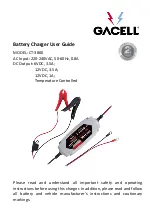
2
45
ABS, EBD, HBA and BOS
systems
The vehicle is equipped with
ABS
(Anti-lock Braking System) and
EBD
(Electronic Brake force Distribution)
systems, which are designed to
help enhance the braking system
performance by means of the
ABS
system sensors and ECU.
In the event of emergency braking
or braking on slippery road surfaces
(e.g., snow, ice etc.) the
ABS
, in
combination with the standard
braking system, allows the driver
to apply maximum braking force
without causing the wheels to lock
and consequently losing control of
the vehicle.
The system uses an electronic control
unit that processes the signals coming
from 4 sensors fitted on the 4 wheels.
When a wheel tends to lock, the
sensor warns the ECU, which activates
an electro-hydraulic unit that
modulates the pressure applied to
the brake calipers; the driver will feel
a “pulsing” sensation on the brake
pedal which is completely normal.
The vehicle is equipped with another
system to assist braking:
HBA
(Hydraulic Brake Assistance), which
has been designed to help the driver
during emergency braking.
In the event of a critical situation,
where the vehicle should stop in
the shortest possible distance, the
driver usually depresses the brake
pedal quickly, but often not strongly
enough: this increases the braking
distance. This system has been
designed to apply optimal braking
force during emergency braking,
in order to stop the vehicle in the
shortest possible distance.
The system recognizes the emergency
condition by analyzing certain
parameters, such as the pressure on
the brake servo, the wheel speed and
activation of the third stop.
The
ABS
control unit is designed to
cross-check this data and substitute
the driver by activating the braking
system full power, so helping to
ensure optimal braking performance
in the shortest possible distance.
To complete the range of systems
that assist braking, the vehicle comes
equipped with
BOS
(Brake Override
System), which is designed to stop
the vehicle even when it is being
accelerated.
If the brake pedal is depressed
together with the accelerator, the
engine power should be automatically
reduced and, if the driver continues
to depress the accelerator, the system
may even cause the vehicle to come
to a complete stop. Additionally, if
the brake pedal is released when
the accelerator is still depressed, the
corresponding engine torque can be
reached gradually.
In the event of a failure, the system
will be deactivated, but this will not
affect the efficiency of the standard
braking system.
The failure will be indicated by the
illumination of the dark yellow
warning light
with the letters
“ABS” on the instrument panel.
In this case, we recommend you
contact the nearest
Authorized
Maserati Dealer
, where the problem
will be immediately identified
through the self-diagnostic function
of the system.
The vehicle must be
equipped only with wheels,
tires and brake pads of the
type and make approved by the
Maserati S.p.A. for this model.
Regardless of the fact that
this device enhances safety
levels, it is essential to
always drive with the greatest care
when the road surface is wet, covered
with snow or ice.
Summary of Contents for GranTurismo Sport 2015
Page 1: ...2015 Owner s Manual...
Page 3: ...3...
Page 6: ...6 3500 GT Mistral coup Ghibli coup...
Page 14: ...14...
Page 17: ...1 17 Homologation labels Safety standard label V I N label Chassis type and number...
Page 18: ...1 18 Emission control data label...
Page 19: ...1 19 Instruction labels Tire speci cation label Lubricant label Mercury content warning label...
Page 20: ...1 20 Anti freeze label...
Page 22: ...22...
Page 36: ...9 2 5 13 8 1 15 16 12 11 10 7 6 3 4 14 2 36 Front and side airbags...
Page 58: ...58...
Page 88: ...88...
Page 119: ...B A 4 119 Controls A Display B Multi Media System controls...
Page 123: ...A A B E F C D D A 4 123 Air conditioning...
Page 231: ...9 231 Table of contents Table of contents 232 Alphabetical contents 236...
















































